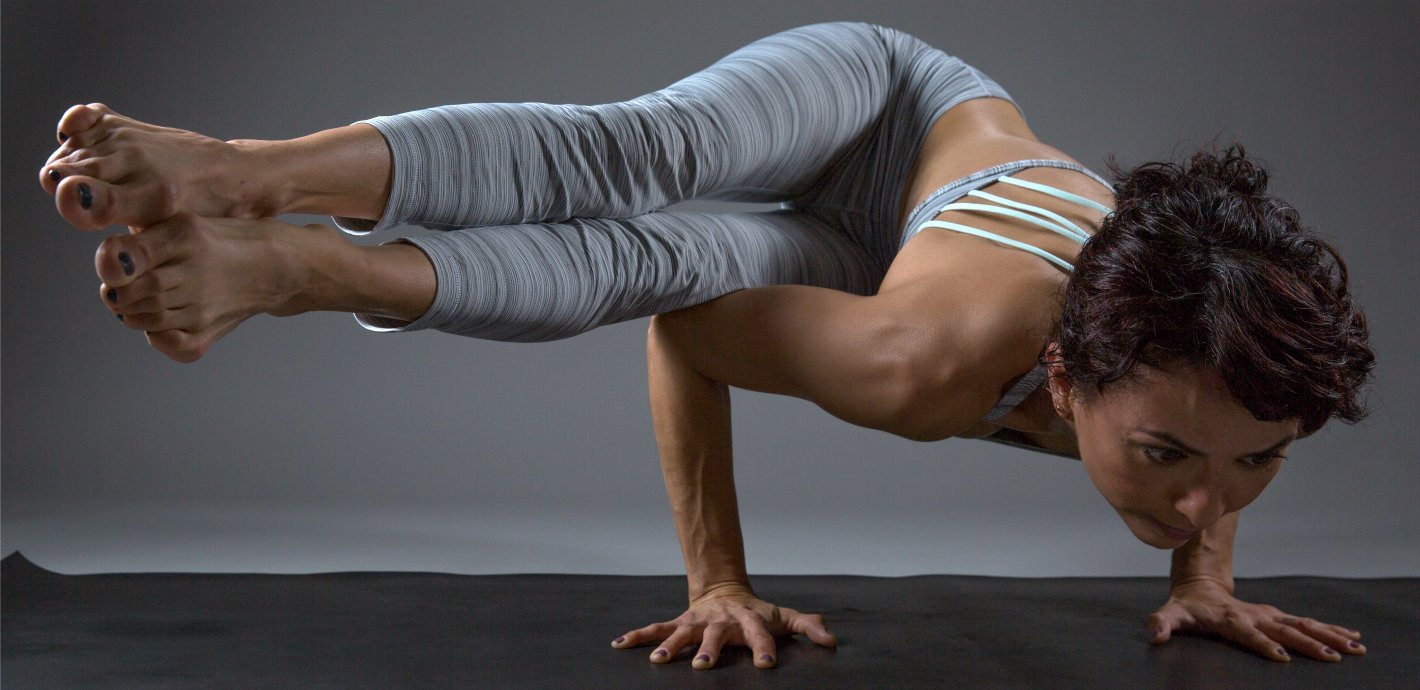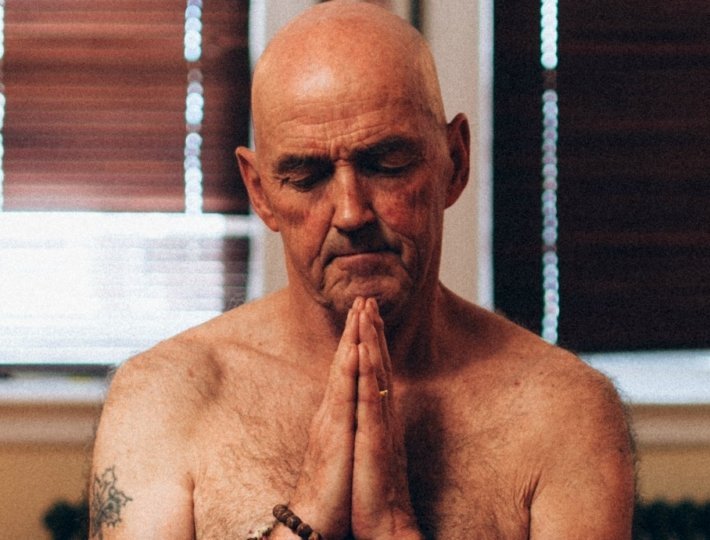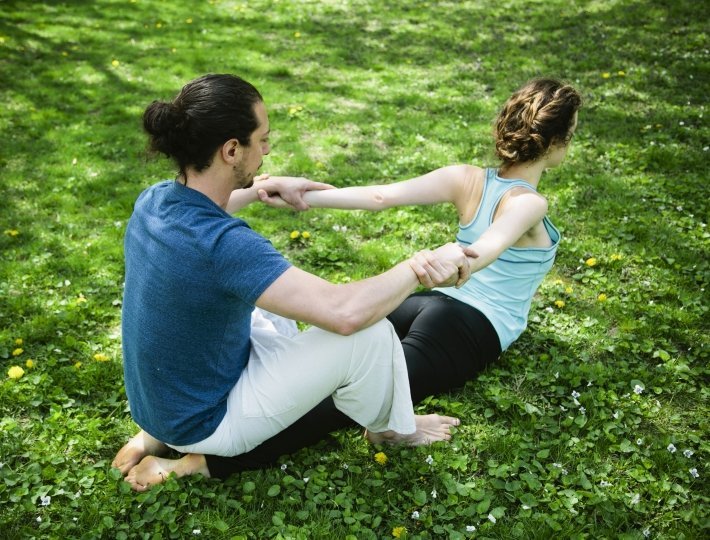I discovered Ashtanga in the mid-90s and was taught the Primary Series within the first year of my studies. For me, yoga came easy, or at least the flexibility part thanks to spending my youth as a gymnast and athlete. I fell in love with the practice and instantly knew that I wanted to become a teacher, which meant that I needed to go to Mysore, India—the birthplace of Ashtanga yoga where students can go to receive certification, or authorization, to teach. Seven years after my first Utthita Hasta Pādāṅguṣṭhāsana, I finally gathered the courage and money to go straight to the source.
My first trip to Mysore in 2003, Pattabhi Jois and his grandson Sharath Jois taught me the complete Intermediate Series, also known as Second Series, within an accelerated month-and-a-half timeframe. After practicing only the Primary Series at home for seven years, Intermediate Series felt fast, challenging, exhilarating, and exhausting. Second series targets the nervous system and, since I was practicing a whole new set of postures, it was an intense experience that felt overwhelming, yet exactly right for me. I returned home to San Francisco, California with a whole new practice and purpose.
I continued to study in Mysore for the next eight years, naïvely assuming that every trip would be the same as the first, where my practice grew exponentially in a short period of time. But no trip was ever like that first one. For eight years, I did not learn a single new posture.
At the halfway point of this yoga rut, I remember asking Sharath, the Ashtanga lineage holder and my guru in Mysore, if there was anything I should be doing differently. Honestly, it was my sneaky way of making sure he knew I was there. He advised me to carry on, assuring me that he would tell me when it was time to move on. This satisfied me at the time, but the following year, nothing changed other than my frustration levels. I watched as newer students arrived in Mysore and were taught Advanced Series A, also known as Third Series, and beyond. I also watched men and women who struggled to execute some of the Intermediate Series postures move on, too. We all know that asana is just one part of the yoga practice, but I couldn’t help comparing myself to others, and, as a result, felt left out, ignored, and, sometimes, betrayed.
I was a dedicated student after all. I didn’t study with anyone else. Pattabhi and Sharath were my only teachers. I did not add postures in between Mysore trips. I could complete all the physical demands of the practice with relative ease. So why wasn’t I “graduating” to Third Series? Other Ashtanga teachers (both authorized and certified) validated my confusion. They would ask what was happening with my practice. Some suggested that Sharath had forgotten about me or that he was willfully neglecting me. Some teachers even offered to teach me Third Series, despite not knowing me or my practice. No one suggested that perhaps I wasn’t ready. No one.
That following trip, in 2007, I respectfully approached Sharath about learning more asanas. He told me that I wasn’t strong enough to start Third Series; that my spine was lacking structure, and beginning Third could cause damage. “I will teach you when you’re ready,” he said, dismissively. Hearing specifics allowed me to breath a sigh of relief, but I was still bewildered. Wasn’t Third Series supposed to build strength and stability? Wouldn’t that be the antidote to my hypermobility?
One day, out of curiosity, I attempted Eka Pada Bakasana A, one of the many (and most difficult) arm balances in Third Series. After pushing against the floor with all my might, desperately trying to lift my head while at the same time balancing the weight of my legs over my body, using all my strength and willpower, I crumbled in a quivering mess on the floor. That’s when I realized that my desires were way bigger than my abilities.
Worst of all, I was not trusting my teacher. Instead, I was coveting postures. I was treating them like objects for me to own and conquer. I was hardly alone in this superficial desire. It seemed like everyone wanted to practice Third, and every teacher wanted to teach Third, like it was a sort of Holy Grail, or a symbolic indication that you belonged in the community. Once reality set in, I decided to listen to my heart and stuck with it.
Truth is, even after four years of practicing Second Series daily, my breathing was still choppy and disheveled. During Mysore classes, I needed to give myself mini breaks here and there in order to slow my heart rate. But in led class, as we all know, there was nowhere to hide. This was a genuine indication for me of what I needed to work on.
Eventually, I decided if I were to continue spending so much time, energy, and money traveling and studying with Sharath, then I needed to just trust him. Over the next four years, I turned my attention (and obsession) away from the postures and toward maintaining a steady breathing pattern throughout my practice. I stopped talking about my practice with others and I stopped listening to their opinions.
Those four years were crucial for my learning. Not only was I able to stabilize my breathing throughout Intermediate Series, but also I could feel my nervous system begin to equalize and my mind responded accordingly. My emotions became more stable, and my reactions to internal thoughts became less dramatic. This also brought me a whole new awareness of bandha—locks in the body that help contain the energy, strength, and physical/spiritual intelligence that you’re building through asana practice. This was something that I had understood on an intellectual level, but had always been too flexible to apply practically. Bandha awareness brought the stability and strength in my spine and shoulders that was necessary for the powerful arm balances of Third Series.
Once Sharath noticed those changes, I was taught Third steadily in about three trips, over the course of one and a half years. There was more structure in my hips and shoulders that allowed me to move through the series safely. Since then, Third Series, albeit intense, has always felt accessible, safe, and profound. Luckily, I’ve had the good fortune of no major injuries for years. Looking back, now six years later, I can’t thank Sharath enough for keeping me in the same place for so long.
It’s easy to blame students for being overeager, but teachers can be guilty of this as well. Teaching students safely and appropriately requires a certified teacher who has practiced Third Series daily for years. Most importantly, the teacher needs to be intimately familiar with the student’s daily Mysore practice, not just through weekend workshops or retreats. As hard as it was for me to fully comprehend at the time, I now believe there’s nothing wrong with spending years in one series or on one particular posture in order to better understand yoga. If either the student or teacher becomes impatient and overly ambitious, then waiting becomes a necessity. More time, not more asana.
Photography by Melisa Hall of Melissa Hall Photography












Comments (0)